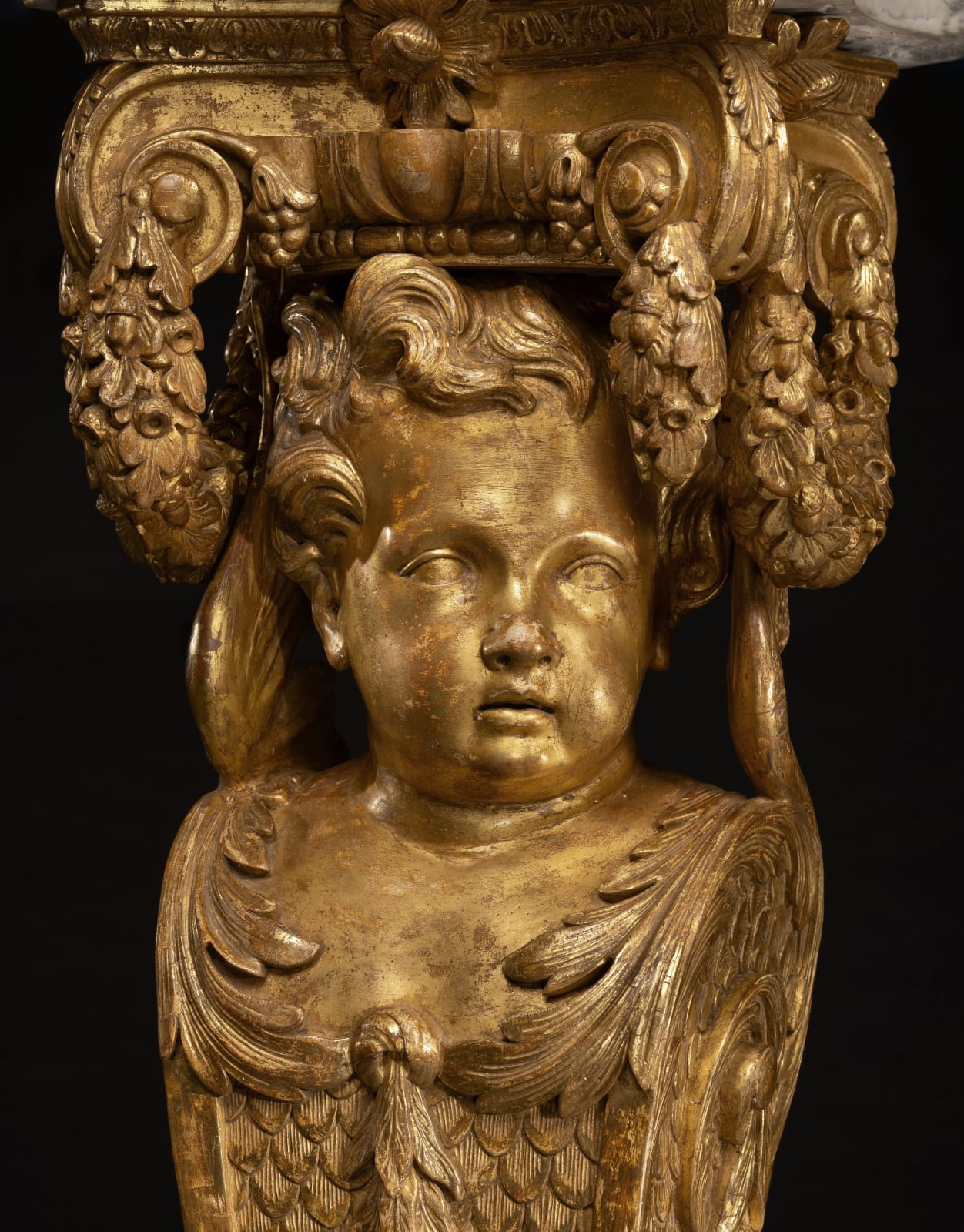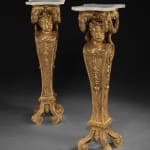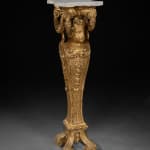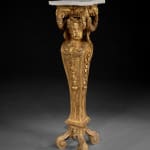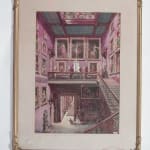
Staircase, Elvaston Castle, Derbyshire. Watercolour dated 1857, by Rebecca Dulcibella Orpen Ferrers.
THE STANHOPE PEDESTAL TERMS, English, circa 1735
Width: 15 in; 38 cm
Depth: 15 in; 38 cm
Further images
A pair of George II giltwood pedestal terms designed by William Kent and carved by Benjamin Goodison.
Note: The marble tops are of later date. The terms retain most of the original gilding.
These extraordinary pedestal terms belong to a small group of pedestals all featuring conical square bodies with naturalistic human heads - in the case of the set to which this pair belong, children’s heads - supporting a column capital. The design of this group is generally ascribed to William Kent.
There are known commissions for pedestal terms in this group for Rousham House in Oxfordshire, Rainham Hall in Essex, the Royal Collection for the White House at Kew in Middlesex and Hampton Court in Surrey, Devonshire House and Chiswick House in London, and lastly Elvaston Castle, where the current pedestals, commissioned by William Stanhope, 2nd Earl of Harrington, originate.
This pair were originally part of a set of eight. Four pedestals can be seen in situ on a staircase landing at Elvaston in a 19th century watercolour painting, each one supporting a white bust.
Two pedestals from the Stanhope set were sold from the Chrysler Collection in 1960, and another pair from the set was acquired by the Victoria and Albert Museum in 1962 as part of the C. D. Roth bequest. The remaining four (two of which are the current pair) were sold directly by the order of the Earl of Harrington together with the remaining contents of Elvaston Castle in 1963. In this sale, held by Sotheby’s, the set of four pedestals were sold together as lot 167. The preceding two lots, 165 and 166, were also pedestal terms, but of slightly different design, featuring heads of women or older girls rather than of children as in the set of eight.
The pedestals from the Roth Collection and the Chrysler Collection had evidently left Elvaston Castle some years before the Sotheby’s sale.
The similarities between the Royal set for Kew and Hampton Court and the Stanhope set are striking. Even more intriguing is that within both sets each head is different, suggesting that they were modelled on actual people, whereas a generic head would surely have been copied and repeated as many times as needed. Their identities are unfortunately unknown, but further research may eventually reveal them.
A related pair of giltwood tables designed by William Kent for Lord Burlington’s villa at Chiswick also feature a child’s head. A sketch by Kent of Lord Burlington’s daughter, Dorothy, drawn within a column capital, is the design basis for these two tables, one of which is in the collection of the Victoria and Albert Museum in London.
Provenance
William Stanhope, 2nd Earl of Harrington, for Elvaston Castle, Derbyshire, England;
By descent until 1963;
Mallett & Son Ltd., London, England;
Private collection, England.
Literature
Parke-Bernet Galleries, ‘The Walter P. Chrysler Collection of English Furniture, Part II’, sale catalogue, New York, 29-30 April 1960, p. 125, lot 526.
Sotheby’s, ‘Important English Furniture, Carpets and Rugs’, sale catalogue, 8 November 1963, p. 45, lot 167.
Desmond Fitzgerald, Georgian Furniture, 1969, item 28.
Susan Weber, William Kent: Designing Georgian Britain, 2014, p. 156, fig. 6.9.
Illustrated:
19th century watercolour of the staircase at Elvaston Castle by Rebecca Dulcibella Orpen Ferrers.
Country Life, Sotheby’s advertisement for the forthcoming sale at Elvaston Castle, 24 October 1963, supplement 31.


